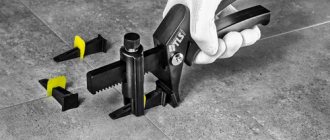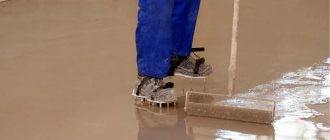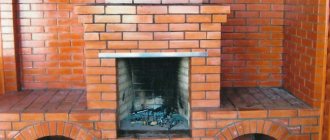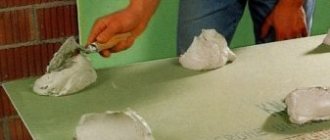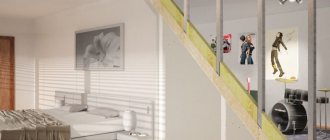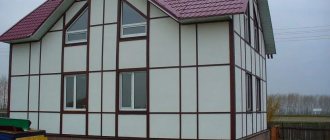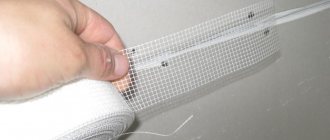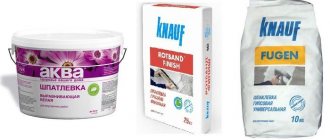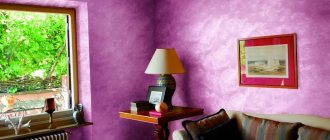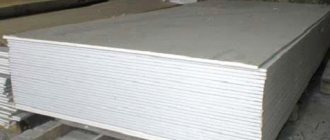The evenness of the walls in an apartment is an issue that most of us suffer from. And it doesn’t matter that it is not visible to the naked eye. The main thing is that we are calm, that everything is done with geometric precision. In such a situation, dry plaster comes to the rescue.
Leveling the walls with plasterboard and even doing it yourself will help you do this much faster than using conventional plaster mortar. Although a lot will depend, as you may have guessed, on the evenness of your walls. If their curvature is more than 4 centimeters per two linear meters, then you most likely will not use our option. Today we will look at the frameless method of leveling with drywall.
How to hide a crooked corner: surprise, and that’s all
Not every new building can boast of ideal walls and corners, let alone the old building.
But nowadays every problem has a solution. There are several ways to disguise a crooked corner so that guests don’t even think that there are problems in this area of the apartment. Shelves with interesting figurines and souvenirs on them will distract attention from defects.
You can decorate the corner with pictures or photo frames with the best shots from your life.
Artificial stone, brick or other decorative material is an excellent solution to the problem.
The unevenness of the corner will be well hidden by striped wallpaper, which will visually distract attention from it.
The internal uneven corner will be covered with a decorative column or whatnot.
And it doesn’t matter at all whether it is an internal or external corner. After all, a creative owner can handle any task. And when eliminating the shortcomings of builders, there is an excellent opportunity to show creativity.
Source
Cost and timing of plastering manually and mechanized
| Application method | Deadlines | Costs of materials, rub./sq.m | Application cost rub./sq. m |
| Manual | Low productivity - application can be applied to 10-30 m2 per day, drying - from 14 days | From 230 | From 600 |
| Mechanized | High productivity - application can be applied to 200-250 m2 per day, the mixture dries in a period of 7 to 14 days | From 200 | From 450 |
Decorating corners in an apartment: places of application
Corner profiles are used when repairing the following elements:
Door and window slopes
Traditionally, double-glazed windows are equipped with special corners that complete installation. The door kit also includes fittings and platbands. These elements protect the slopes from damage and have an aesthetic function.
If the corners are not closed, then selecting these elements yourself is not difficult. A suitable option is plastic corners. By choosing the required profile color, you will make the transition of a door or window opening smooth and less noticeable.
Horizontal joints of ceilings, floors and walls Corners for ceilings and floors are usually called plinths, and they are practically the same as corners for walls. Ceiling profiles can also be called baguettes, fillets or moldings.
A foam ceiling baguette is the easiest to install in an apartment
Such an L-shaped plinth necessarily has two flat and smooth surfaces that are attached to the ceiling and wall, and two front surfaces with a relief or ornament m. The fillets are fastened in different ways depending on the material; the foam baguette is, for example, glued to silicone or liquid nails.
One of the popular floor models is a plastic plinth with a collapsible design. The base of such a plinth is attached to a dowel-nail to the wall, then the front colored part is attached to the base using a special lock. Floor and ceiling profiles are made from various materials: PVC, polyurethane, dupolymer, wood, metal. Ceiling corners are also produced in gypsum and foam.
Corners of decorative partitions, openings, including arches
Popular doorways in apartments are semicircular arches. The contours of this design can be repeated by corners made of flexible plastic, veneer, MDF or bamboo.
Where walls and showers or bathtubs meet
The dimensions of a standard bathroom in apartment buildings suggest installing a shower or bathtub in one of the corners of the room. At the same time, the joint between the surfaces must be carefully and securely closed and protected from water getting under the bath.
Skirting boards for the bathroom are ceramic marble, plastic, acrylic, and there is also a self-adhesive border made of PVD and silicone profiles.
The easiest to work with and cheapest option is a self-adhesive border. Its only drawback is its service life, since such a corner needs to be changed after 1-2 years.
Joints of countertops and aprons or countertops and other objects.
Installation of any kitchen set is completed by installing corners at the joints of the countertop and apron. The plinth here not only has a decorative function, but also prevents water and food residues from getting behind the countertop, and also hides defects and damage that occurred during installation. new kitchen.
Kitchen profiles can be plastic, aluminum, wood, stone. Aluminum plinths are resistant to temperatures and chemical influences, plastic ones come in a variety of colors and designs, wooden and stone ones are environmentally friendly. The choice depends on various factors.
The shape of the borders is also varied: flat, curly, rounded, convex, or vice versa.
Vertical wall joints - internal or external
Wall corners, especially in walk-in rooms or narrow corridors, are often susceptible to accidental contact, friction or even impacts. They can be damaged by moving furniture, children or animals playing. This is why designers and/or owners decide to decorate the wall joints with decorative corners. However, corners are used not only for this purpose.
A transparent acrylic profile with ornamentation will complement the wallpaper design and make it sophisticated
Why use wall corners?
Improving the appearance of the finish
Decorative corners on the corners of walls are used to give a finished appearance and decoration - like a photo frame or lace for a tablecloth. This technique works both with the same wall finishing material and when transitioning from one material to another.
Protection against damage and contamination
External corners, especially in the hallway or hallway, are susceptible to damage: abrasion, accidental impacts or scratches. Such defects appear due to carelessness, and durable decorative corners will help to avoid them.
Docking material
When finishing walls with hard materials not intended for corner transitions, difficulties arise precisely at the junction of two surfaces adjacent at an angle. For example, plastic panels, lining, stone or tiles require decorative design of the joint.
Adding functionality or decoration
How to decorate the corners of an apartment beautifully and, if possible, functionally in a non-standard layout? In such a case, the designer faces a difficult task - he needs to save space or make an inconvenient corner useful. The solution lies, for example, in arranging a corner with furniture that turns it into a place for reading, relaxing, or a house for animals.
Types of decorative corners
Corners can be considered a universal finishing material; they are used in the bathroom, in the kitchen, in the nursery and even on the balcony. Not only walls are decorated with corners, but also fireplaces, stoves, and furniture. The appearance of the corners and their technical characteristics directly depend on the material from which they are made. The material also determines the scope of use of the corners. According to the material and scope of use, there are several types of corners:
Metal
The most popular metal angles are made from aluminum, brass and steel. This type of corners is rarely used for finishing residential premises - more often in furniture production. Brass and steel corners have a smooth polished surface.
The aluminum profile can also be of a natural color with polishing, as well as anodized with a coating of any color. Such corners are usually used to match the tone of the material with which the walls are decorated.
Wooden
This type includes models made of bamboo, cork, MDF or natural wood. Mainly used for finishing external and internal corners of walls lined with clapboard, natural board or similar material, but also suitable for finishing wallpaper of any kind. go type.
Natural wood corners are made from different types of wood, additionally painted, varnished, and sometimes may have patterns on the surface.
Wooden corners are an excellent solution for attic balconies and bathhouses lined with wood. Such corners are fastened using secret nails and/or carpentry foam. Of the mines, the low is the low and the Xpykkok, the same is not for the time and the sole of the same Lami.
Silicone
This type of corners is suitable for framing joints of wallpaper or painted surfaces. In addition to aesthetics, the silicone profile will make the corners less dangerous when it comes to a children's room.
In addition, it is resistant to water, so it is used in the bathroom and can even be installed on an uneven surface due to its flexibility. To attach such corners, a sticky corner base is used.
The disadvantage of silicone corners is their instability to household chemicals, which makes care more difficult. For cleaning, you should use non-aggressive means.
Polyurethane
Such corners are produced using the pressing method, they have a smooth surface and complex relief. Such profiles are wear-resistant, they are not afraid of moisture and temperature changes. Unlike plastic, they are thicker, which can complicate the installation process, but polyurethane profiles are easy to paint if necessary.
Polyurethane corners imitate gypsum stucco molding, wood texture, and can be simply white or with gilded ornaments. Fits perfectly into a classic interior. To attach them, polyurethane glue is used.
Corners made of decorative stone
Elements made of stone are usually used to decorate the facades of houses, but if the interior of the apartment also has stone trim, such profiles will fit organically here too. You need to choose flat stones, they will add aesthetics to the structure. The stone corner combines harmoniously with decorative plaster, wooden panels, and even ordinary wallpaper.
How to design the corners of walls in an apartment: photo
The easiest to use is a decorative flexible stone. The material is lightweight, but at the same time durable, and can be mounted on any surface using liquid nails.
Flexible stone, despite its lightness, is a very durable and wear-resistant material
Under the influence of hot air, the stones become soft and pliable, thanks to which they can be attached at any angle, even at imperfect angles. This stone has a rough surface and varied texture, resistant to mechanical influences.
Flexible artificial stone can be mounted directly on the corner
Ready-made corner elements are also distinguished by quick installation. This L-shaped tile, imitating stone, consists of a short and a long part of a brick. These same elements can be used to decorate arches and slopes.
Corner elements of artificial stone based on gypsum
To cover a wall without using ready-made corner elements, the edges of decorative stones are cut at an angle of 45 degrees and brought together with this part.
Further work is carried out according to the usual pattern - the seams are rubbed with cement grout. For internal corners, we will use only the second option with sawing, since ready-made internal corner elements are not produced.
Source
Don't be afraid of experiments
If you're not afraid to make bold decisions, paint uneven walls black or dark blue. Of course, such an interior is not suitable for every owner - so that the dark color does not depress, use popular decorating techniques. Do not point lamps at walls - black absorbs light. The rays should come from the walls: choose lighting fixtures that can be hidden under plasterboard structures or “recessed” in a niche. Don't neglect bright decorative elements - they will enliven dark walls.
How to glue a plastic corner yourself
In addition to decorative corners, you will also need a fastening compound. For narrow elements it is not recommended to use glue, the excess of which cannot be removed from the surface without leaving a trace. Before carrying out the procedure, the joint must first be cleaned of dirt and remnants of wallpaper or protruding pieces of finishing material. No corners will save an excessively uneven and bumpy surface. Then the wall is measured. The measurements are exactly transferred to a piece of corner. It is better to cut the material with a hacksaw with fine teeth. Do not forget about the joints between the corners themselves (in doorways, windows): two straight lines should end with cuts at an angle of 45 degrees. The “wrong” side of the prepared material is coated with glue and applied to the wall. Using your hands, firmly press the corner to the surface and hold it until the fastening composition “seizes”
Decoration
If your wall in the interior design should be empty, that is, there is no furniture adjacent to it, and there is no urgent need to create a perfectly flat surface, then the problem can be solved with the help of decor. This will save money on building materials and give free rein to your imagination, turning uneven areas into a source of pride.
Decorative plaster
This method of visually leveling walls is the most popular, and textured mixtures will not only hide possible unevenness, but will create a unique style for the entire room. You can choose any color and shade, as well as application methods. If desired, such plaster can be painted at the request of the customer. The only limitation is your imagination.
If the discrepancy in level near the baseboard of the floor and at the ceiling is impressive, but this wall will not be used for furniture, you can make a whole panel from decorative plaster, giving free rein to your imagination and creativity.
Advantages:
Flaws:
Gypsum products go well with decorative plaster. They are glued to the wall, complementing the design. This option is convenient and practical only on those walls that will be open and not used in the interior.
Living ornamental plants
If the problematic wall is directly in sight, then all its disadvantages can easily be turned into advantages. To do this, it is enough to apply any coating (plaster, liquid wallpaper, textile wallpaper), and drive decorative nails on top in a chaotic (or strictly directed) order, stretching a thread between them. Place flowerpots with climbing flowers at the bottom, placing the vines on stretched threads. As the plants grow, their lashes will spread over the entire wall, thereby hiding all the unevenness and roughness of the repair.
Advantages:
Flaws:
A kind of living corner where it would be nice to place a table and a few armchairs. Beautiful, bright, not boring and always lifts your spirits. Decorative butterflies or birds of paradise can be placed between the lashes.
Volumetric decor
Various posters, paintings, panels framed in massive frames will help to hide the unevenness of the wall and shift attention. The cheapest option would be to make a gallery of your own photographs on the wall, displaying the most pleasant moments of life. There can be as many of them as your heart desires.
Advantages:
Flaws:
You can also use various pottery, all kinds of plates, mugs, and antiques as three-dimensional decor. They will turn a gloomy and boring (and also crooked) wall into a source of pride.
Photo wallpaper with 3-D effect
Photo wallpaper with a complex multi-stage pattern will help to visually hide all the unevenness. An optical illusion that eliminates the need to spend money on building materials for leveling, it fits well with any interior.
Recently, wallpapers with images of wild stone and imitation brickwork are often used in interiors. The multi-level structure allows you to deceive the eye so that even the most impressive irregularities and discrepancies will be invisible.
Advantages:
Flaws:
If the stores don’t have what you need, you can order photo wallpaper from the manufacturer by providing your personal sketch with measurements.
Liquid wallpaper
In addition to the fact that you can choose any shade, liquid wallpaper independently levels the walls, filling all the holes and smoothing out unevenness on the surface. This is one of the simplest and most accessible means that have recently begun to be used instead of plaster. They are easy to apply to the wall, lay down softly, dry well and do not cause any difficulties in use.
Advantages:
Flaws:
Liquid wallpaper needs to dry well, so after applying it the room should be warm.
How to level walls with plasterboard using glue
Before leveling curved concrete or any other walls, you need to prepare tools and equipment: drywall, spatulas, usually pencils for marks, glue or primer mixture, a roller or brush for applying the composition, a mixer for mixing.
The stages of our work include the following sequence:
- Preparing the surface to remove dust and dirt.
- Mixing the glue by adding water to the dry powder according to the proportions on the package. The composition for plasterboard walls must be mixed for at least 5 minutes.
- Gluing drywall in one row with a distance of 30 centimeters. The sheet is applied to the gasket using a rule and a level. It would also be useful to strike with a rack for better grip. Installation of other elements is also carried out.
- Application of putty composition.
Leveling materials and coatings
If you plan to use the wall as a place to mount furniture, then any unevenness in this case will cause a lot of inconvenience. It will take time to fix this. But the modern building materials market offers the simplest, most convenient and practical options that will quickly and efficiently solve the problem without much expense.
Drywall
This cladding material has an increased level of environmental friendliness and can be used in residential areas. With its help, the ideal level direction of the wall is created, which is especially important for the upcoming installation of furniture.
Special slats are attached to the wall, onto which sheets of drywall are mounted using self-tapping screws. Next comes plaster, and the final stage can be wallpaper.
Advantages:
Flaws:
Drywall is the most convenient material for leveling walls, but its installation has some difficulties, so you will have to use the services of specialists.
Cork panels
Cork panels have won the love of many designers, since with their help it is possible not only to create a unique texture, but also to hide the imperfections of any wall. They are glued to a special solution, have no difficulties in operation, and are suitable for all types of interiors.
Advantages:
Flaws:
Cork panels must be glued extremely carefully, since after gluing it will not be possible to move them even a millimeter.
Wooden lining
The installation principle is similar to plasterboard, but its distinctive feature is its minimal thickness. If various interior items are adjacent to the wall. There is a risk of dents forming on individual structural elements. Lining is more about “hiding”, but not about “durable and reliable”. It is easy to clean, there are a lot of colors and textures. As for environmental friendliness, it’s definitely not worth using for the bedroom, but in the kitchen such a coating will come in handy.
Advantages:
Flaws:
In conclusion, it is worth noting that crooked walls are not a reason for large-scale repairs. If the surface does not carry a functional load, it can be decorated in such a way that no one would even think of looking for the builders’ flaws. Use your imagination, create, but remember that any idea must be practical, because it is embodied not in a museum, but in a living space.
Plastic corner size
The standard range of sizes for PVC corners starts with 10x10 mm and ends with 50x50 mm. Between them, gradations with a difference of 5 mm are used. Parts of non-traditional sizes are made to order. An angle of 90 degrees is maintained between the two guides of the decorative element, at which all planes of the apartment must intersect. If you have a home with “crooked” walls, then you need to take appropriate measurements and contact a specialist with a request to make individual parts.
